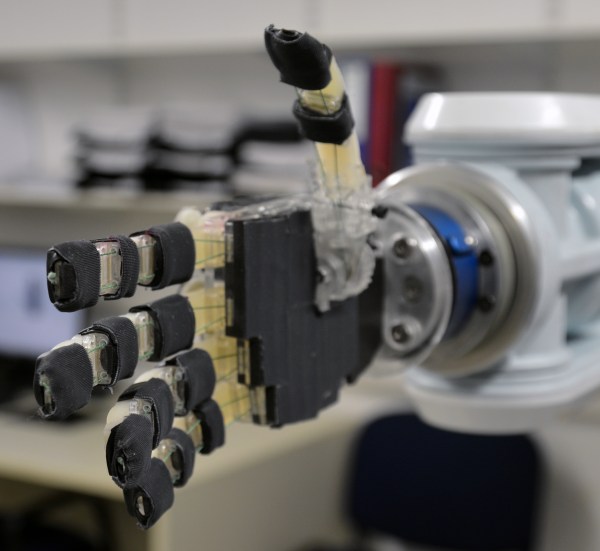Sometimes, the most amazing teams make the most wonderful things happen, and yet, there is just not enough time to finish all the features before the product ships. This is what happened to Raimi, who came to this world missing a right hand and half of her right forearm. Raimi is now 9 years old, and commercial mechatronic prostheses are still only available to those who can afford them. When Raimi’s father approached [Patrick Joyce] to ask him for help in building an affordable prosthesis, he knew it would matter, and went right to work.
prosthetic hand11 Articles
Hackaday Prize Semifinalist: OpenBionics Affordable Prosthetic Hands
The human hand is an amazing machine, and duplicating even a fraction of its abilities in a prosthetic is a daunting task. Flexible anthropomorphic prosthetics can reach tens of thousands of dollars and are beyond the means of many of the people who need them. So imagine the impact a $200USD prosthetic hand could have.
For such a low, low price you might expect a simple hook or pincer grip hand, but the OpenBionics initiative designed their hand from the outset to mimic the human hand as much as possible. The fingers are Plexiglas with silicone knuckles that are flexed by tendon cables running in sheaths and extended by energy stored in elastomeric material running along their dorsal aspects. Each finger can be selectively locked in place using a differential based on the whiffletree mechanism, resulting in 16 combinations of finger positions with only a single motor. Combined with 9 unique thumb positions, 144 unique grasp are possible with the open source hand built from hardware store and 3D printed parts. Stay tuned for a video of the hand in action after the break.
3D printing is beginning to prove it’s the next big thing in prosthetics. Hackers are coming up with all kinds of static artificial hands, from the elegant to super-hero themed. Maybe the mechanism that OpenBionics has come up with will find its way into these hands – after all, it is an open source project.
Continue reading “Hackaday Prize Semifinalist: OpenBionics Affordable Prosthetic Hands”
Hackaday Prize Entry: Biohand
One of the greatest uses we’ve seen for 3D printing is prosthetics; even today, a professionally made prosthetic would cost thousands and thousands of dollars. For his entry to the Hackaday Prize, [Martin] is building a low-cost 3D printed hand that works just like a natural hand, but with motors instead of muscles and tendons.
There are a lot of 3D printed finger mechanisms around that use string and wires to move a finger around. This has its advantages: it’s extremely similar to the arrangement of tendons in a normal hand, but [Martin] wanted to see if there was a better way. He’s using a four-bar linkage instead of strings, and is driving each finger with a threaded rod and servo motor. It’s relatively strong; just the motor and drive screw system was able to lift 1kg, and this mechanical arrangement has the added bonus of using the servo’s potentiometer to provide feedback of the position of the finger to the drive electronics.
This is far from the only prosthetic hand project in the running for The Hackaday Prize. [OpenBionics] is working on a very novel mechanism to emulate the function of the human hand in their project, and [Amadon Faul] is going all out and casting metacarpals and phalanges out of aluminum in his NeoLimb project. They’re all amazing projects, and they’re all making great use of 3D printing technology, and by no means are there too many prosthetic projects entered in The Hackaday Prize.
Wounded Soldier Gets Robotic Hand Replacement
[Neal Muzzy], a local member of the Cedar Valley Makers makerspace, just made news on Open Bionics for his robotic prosthetic hand called Dextrus v1.2 which he made for his friend, and wounded war veteran, [Taylor].
In just two months, [Neal] worked with his friend to make this robotic prosthetic with the goal of having it more functional and easier to use than [Taylor]’s current prosthetic. The very first prototype was made by using the open-source Dextrus design, to test fit, and control using EMG sensors. Once they determined it would work — onto customizing!
They call it Dextrus V1.2, and it works better for [Taylor] than the original — but that’s the whole point of the Open Hand project — starting with a base design, and making it better. If you’re not familiar with the Open Hand Project, it was originally crowd-funded on Indiegogo, and is now an organization to make robotic prosthetic hands more accessible to amputees. We wrote about it in Hacklet 41 – Prosthetic Projects.
Continue reading “Wounded Soldier Gets Robotic Hand Replacement”



















